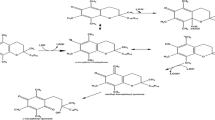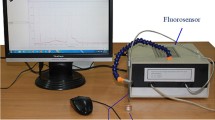Abstract
Total luminescence spectroscopy was used to characterise and differentiate edible oils and additionally, to control one of the major problems in the oil quality—the effect of thermal and photo-oxidation. We studied several vegetable oils available on the Polish market, including soybean, rapeseed, corn, sunflower, linseed and olive oils. Total luminescence spectroscopy measurements were performed using two different sample geometries: front-face for pure oil samples and right-angle for transparent samples, diluted in n-hexane. All the samples studied as n-hexane solutions exhibit an intense peak, which appears at 320 nm in emission and 290 nm in excitation, attributed to tocopherols. Some of the oils exhibit a second long-wavelength peak, appearing at 670 nm in emission and 405 nm in excitation, belonging to pigments of the chlorophyll group. Additional bands were present in the intermediate range of excitation and emission wavelengths; however, the compounds responsible for this emission were not identified. The front-face spectra for pure oils included chlorophyll peaks for most samples, and some additional peaks in the intermediate range, while the tocopherol peaks were comparatively less intense. The results presented demonstrate the capability of the total luminescence techniques to characterise and differentiate vegetable oil products, and additionally, to characterize the effect of thermal and photo-oxidation on such products. In the photo-oxidation experiments, special attention was paid to possible involvement of singlet oxygen. Experiments were done to monitor the highly specific O2 (1Δ g ) → O2(3Σ−) singlet oxygen emission at 1270 nm. Thus, total luminescence spectroscopy presents an interesting alternative to time-consuming and expensive techniques such as gas or liquid chromatography, mass spectrometry and other methods requiring wet chemistry steps.
Similar content being viewed by others
REFERENCES
P. B. Oldham, M. E. McCarroll, L. B. McGown, and I. M. Warner (2000). Molecular fluorescence, phosphorescence, and chemiluminescence spectrometry. Anal. Chem. 72, 197R-209R.
I. M. Warner, S. A. Soper, and L. B. McGown (1996). Molecular fluorescence, phosphorescence, and chemiluminescence spectrometry. Anal. Chem. 68, R73-R91.
T. T. Ndou and I. M. Warner (1991). Applications of multidimensional absorption and luminescence spectroscopies in analytical-chemistry. Chem. Rev. 91, 493-507.
J. Guiteras, J. L. Beltran, and R. Ferrer (1998). Quantitative multicomponent analysis of polycyclic aromatic hydrocarbons in water samples. Anal. Chim. Acta 361, 233-240.
D. Patra and A. K. Mishra (2002). Study of diesel fuel contamination by excitation emission matrix spectral substraction fluorescence. Anal. Chim. Acta 454, 209-215.
T. Persson and M. Wedborg (2001). Multivariate evaluation of the fluorescence of aquatic organic matter. Anal. Chim. Acta 434, 179-192.
D. Baunsgaard, L. Norgaard, and M. A. Godshall (2000). Fluorescence of raw cane sugars evaluated by chemometrics. J. Agric. Food Chem. 48, 4955-4962.
D. Baunsgaard, C. A. Andersson, A. Arndal, and L. Munck (2000). Multi-way chemometics for mathematical separation of fluorescent colorants and colour precursors from spectrofluorimetry of beet sugar and beet sugar thick juice as validated by HPLC analysis. Food Chem. 70, 113-121.
R. Bro (1999). Exploratory study of sugar production using fluorescence spectroscopy and multi-way analysis. Chemom. Intell. Lab. Syst. 46, 133-147.
R. Bro, F. van den Berg, A. Thybo, C. M. Andersen, B. M. Jorgensen, and H. Andersen (2002). Multivariate data analysis as a tool in advanced quality monitoring in the food production chain. Trends Food Sci. Technol. 13, 235-244.
S. B. Engelsen (1997). Explorative spectrometric evaluations of frying oil deterioration. J. Am. Oil Chem. Soc. 12, 1495-1508.
A. Cert, W. Moreda, and M. C. Perez-Camino (2000). Chromatographic analysis of minor constituents in vegetable oils. J. Chromatogr. 881, 131-148.
B. G. Osborne (2003) in R. A. Meyers (Ed.), Encyclopedia of Analytical Chemistry, Wiley, Chichester, pp. 1-14.
V. Beaten and R. Aparicio (2000). Edible oils and fats authentification by Fourier transform Raman spectrometry. Biotechnol. Agron. Soc. Environ. 4, 196-203.
P. Giungato, L. Notarnicola, and L. Colucci (2002). in R. Zielinski (Ed.), Current Trends in Commodity Science, Poznań University of Economics Press, Poznań, pp. 513-518.
R. Schmidt, C. Tanielian, R. Dunsbach, and C. Wolff (1994). Phenalenone, a universal reference compound for the determination of quantum yields of singlet oxygen sensitization. J. Photochem. Photobiol. A 79, 11-17.
J. R. Lakowicz (1999). Principles of Fluorescence Spectroscopy, Kluwer Academic/Plenum Publishers, New York.
J. M. deMan (1999). Principles of Food Chemistry, Kluwer Academic/Plenum Publishers, New York.
B. Schoefs (2003). Chlorophyll and carotenoid analysis in food products. Properties of the pigments and methods of analysis. Trends Food Sci. Technol. 13, 361-371.
X. Wang and O. C. Mullins (1994). Fluorescence lifetime studies of crude oils. Appl. Spectrosc. 48, 977-984.
T. D. Downare and O. C. Mullins (1995). Visible and near-infrared fluorescence of crude oils. Appl. Spectrosc. 49, 754-764.
C. Y. Ralston, X. Wu, and O. C. Mullins (1996). Quantum yields of crude oils. Appl. Spectrosc. 50, 1563-1568.
D. Patra and A. K. Mishra (2001). Concentration dependent red shift: qualitative and quantitative investigation of motor oils by synchronous fluorescence scan. Talanta 53, 783-790.
D. B. Min and J. M. Boff (2002). Chemistry and reaction of singlet oxygen in foods. Comprehensive. Rev. Food Sci. Food Safety 1, 58-72.
E. Psomiadou and M. Tsimidou (1998). Simultaneous HPLC determination of tocopherols, carotenoids, and chlorophylls for monitoring their effect on virgin olive oil oxidation. J. Agric. Food Chem. 46, 5132-5138.
S. H. Lee and D. B. Min (1990). Quenching mechanisms, and kinetics of carotenoids in chlorophyll-sensitized photooxidation of soybean oil. J. Agric. Food Chem. 38, 1630-1634.
K. M. Haila, S. M. Lievonen, and M. I. Heinonen (1996). Effects of lutein, lycopene, annatto, and tocopherol on autoxidation of triglycerides. J. Agric. Food Chem. 44, 2096-2100.
F. M. Pirisi, A. Angioni, G. Bandino, P. Cabras, C. Guillou, E. Maccioni, and F. Reniero (1998). Photolysis of tocopherol in olive oils and model systems. J. Agric. Food Chem. 46, 4529-4533.
S. W. Huang, E. N. Frankel, and J. B. German (1995). Effects of individual tocopherols and tocopherol mixtures on the oxidative stability of corn oil triglycerides. J. Agric. Food Chem. 43, 2345-2350.
F. Wilkinson, W. P. Helman, and A. B. Ross (1995). Rate constants for the decay and reactions of the lowest electronically excited singlet-state of molecular-oxygen in solution-an expanded and revised compilation. J. Phys. Chem. Ref. Data 24, 663-1021.
C. M. Andersen and R. Bro (2003). Practical aspects of PARAFAC modeling of fluorescence excitation-emission data. J. Chemom. 17, 200-215.
Author information
Authors and Affiliations
Corresponding author
Rights and permissions
About this article
Cite this article
Sikorska, E., Romaniuk, A., Khmelinskii, I.V. et al. Characterization of Edible Oils Using Total Luminescence Spectroscopy. Journal of Fluorescence 14, 25–35 (2004). https://doi.org/10.1023/B:JOFL.0000014656.75245.62
Issue Date:
DOI: https://doi.org/10.1023/B:JOFL.0000014656.75245.62




